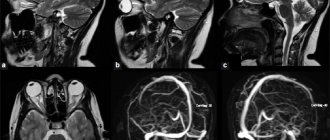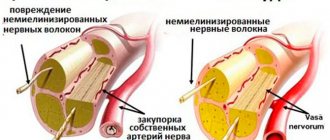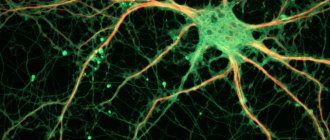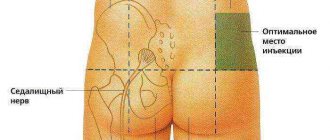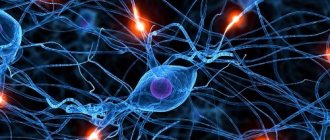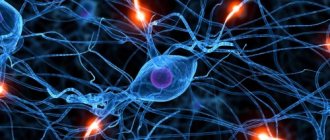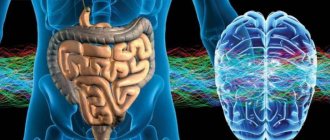Causes
Acute circulatory disorders are a consequence in relation to the affected vessels of the brain or the cardiovascular system as a whole.
In most cases, circulatory disorders in the brain structures are caused by:
- hypertension, regardless of the stage of the disease;
- vascular atherosclerosis;
- combination of hypertension and atherosclerotic process.
Circulatory disorders cannot be ruled out due to the following diseases:
- vasculitis of various origins (with syphilis or infectious-allergic conditions);
- systemic connective tissue pathology (lupus erythematosus, periarteritis nodosa);
- heart diseases (malformations, mitral valve prolapse, endocarditis of bacterial origin, myocardial infarction, arrhythmia of various nature);
- congenital vascular anomalies of the brain (aneurysm, stenosis, occlusion); diseases of the hematopoietic system (blood cancer, erythremia, coagulopathy).
As for spinal disorders, they occur for the following reasons:
- spinal cord vascular damage;
- compression of the vessels supplying the spinal cord at different levels;
- iatrogenic circulatory disorders - consequences of medical procedures.
Clinical classification of vascular lesions of the brain
Classification of vascular lesions of the brain (E.V. Schmidt, 1985) I. Diseases and pathological conditions leading to circulatory disorders in the brain 1. Atherosclerosis 2. Hypertension (essential hypertension) 3. Diseases with symptomatic arterial hypertension 4. Combination of atherosclerosis with arterial hypertension 5. Vasomotor dystonia 5.0. Neurocirculatory dystonia 5.1 Vegetative-vascular dystonia 6. Arterial hypotension 7. Damages of the heart and disorders of its activity 8. Anomalies of the cardiovascular system 9. Damage to the lungs leading to pulmonary heart failure with impaired venous circulation in the brain 10. Infectious and allergic vasculitis 11. Toxic lesions of the brain vessels 12. Diseases of the endocrine system 13. Traumatic lesions of the brain vessels and its membranes 14. Compression of arteries and veins (with changes in the spine, tumors and DR-) 15. Blood diseases II. Disorders of cerebral circulation A. Initial manifestations of insufficiency of blood supply to the brain 1. Initial manifestations of insufficiency of blood supply to the brain B. Transient disturbances of cerebral circulation 1. Transient ischemic attacks 2. Hypertensive cerebral crises 2.0. General cerebral 2.1. With focal disorders B. Stroke 1. Subarachnoid non-traumatic hemorrhage 1.0. Non-traumatic hemorrhage under the membranes of the brain 2. Hemorrhagic stroke—non-traumatic hemorrhage 2.0. Cerebral hemorrhage 3. Other and unspecified intracranial hemorrhage 3.0. Non-traumatic extradural hemorrhage 3.1 Non-traumatic acute subdural hemorrhage 3.2 Unspecified intracranial hemorrhage 4. Ischemic stroke (infarction) 4.0. Cerebral ischemic stroke 4.0.0. In case of damage to the precerebral main arteries 4.0.1. In case of damage to the cerebral arteries 4.0.2. With cerebral artery embolism 5. Stroke with a recoverable neurological deficit - minor stroke 6. Insufficiently specified acute cerebrovascular accidents 7. Consequences of a previous stroke (more than 1 year) D. Progressive cerebral circulatory disorders 1. Chronic subdural hematoma 2. Dyscirculatory encephalopathy 2.0. Atherosclerotic 2.1. Hypertensive 2.2. Venous and other or unspecified vascular lesions D, Other and unspecified vascular lesions 1. Cerebral III. Localization of the lesion 1. Brain hemispheres 1.0. Cortex and immediate subcortex 1.1. White matter (indicating the affected lobe or lobes) 1.2. Inner capsule 1.3. Subcortical nodes 2. Brainstem 2.0. Midbrain (tegmentum, base) 2.1. Bridge (tire, base) 2.2. Medulla oblongata 2.3. Multiple foci 3. Cerebellum 4. Localization not established IV. Nature and localization of vascular changes A. Nature of vascular damage 1. Blockage of the lumen of the vessel 2. Narrowing of the lumen of the vessel (in%) 3. Kinks, looping of vessels 4. Aneurysms: a) saccular; b) arteriovenous; c) carotid-cavernous, arteriovenous anastomosis 5. Other lesions of the arteries 6. Other lesions of the veins and venous sinuses B. Localization of the lesion 1. Common lesion 2. Aorta 3. Innominate artery (brachiocephalic trunk) 4. Carotid artery (common, internal, external ) 5. Subclavian artery 6. Vertebral artery 7. Main artery 8.9.10. Anterior, middle, posterior cerebral arteries 11. Branches of the basilar artery 12. Inferior posterior cerebellar artery 13. Branches of the external carotid artery (meningeal artery) 14. Cerebral veins and sinuses 15. Jugular vein 17. Other vessels 18. Localization not established V. Characteristics of clinical syndromes Subjective symptoms (without objective neurological symptoms) 1. Organic microsymptoms without symptoms of loss of functions (anisoreflexia, slight deviation of the tongue, etc.) 2. Motor disorders (paresis - paralysis, extrapyramidal disorders, coordination disorders) 3. Sensitivity disorders (pain, decreased sensitivity) 4. Impaired function of the sensory organs 5. Focal disturbances of higher cortical functions (aphasia, agraphia, alexia, etc.) 6. Epileptiform seizures (general, focal) 7. Changes in intelligence, memory, emotional-volitional sphere 8 Psychopathological symptoms 10. Other VI. State of ability to work 1. Able to work 2. Temporarily disabled 3. Limited able to work 4. Incapacitated 5. Needs outside help 6. Needs observation, supervision
For more than 20 years, the classification proposed by A.V. Pokrovsky has been successfully used among angiosurgeons. It allows you to navigate quite accurately when determining the validity and timeliness of surgical measures for extracranial lesions of the cerebral arteries. Classification of chronic arterial insufficiency of the brain by A. V. Pokrovsky 1) etiology, 2) localization [all affected vessels and the degree of impairment of their patency (stenosis, occlusion) should be indicated in detail] 3) degree of cerebral circulatory impairment. According to the degree of cerebrovascular accident, we distinguish 4 groups: 1) asymptomatic, 2) transient disorders, 3) chronic vascular insufficiency, 4) stroke or its consequences.
Stage I cerebrovascular accident is characterized by the absence of symptoms of cerebral ischemia in the presence of proven damage to the brachycephalic arteries.
In grade II - transient disorders - transient ischemic attacks of varying severity and duration of no more than 24 hours are observed.
At stage III, general symptoms of slowly progressing vascular disease of the brain without ischemic attacks and strokes are revealed.
The fourth degree is progressively increasing dyscirculatory encephalopathy and severe consequences of stroke.
The clinical classification of chronic arterial insufficiency of the brain, proposed by B. A. Konstantinov and Yu. V. Belov (1996), reflects the functional state of the brain in this pathology. Classification of chronic arterial insufficiency of the brain by B. A. Konstantinov and Yu. V. Belov When assessing the state of cerebral circulation, division into 4 functional classes is used. 1 FC There is stenosis of the artery supplying the brain, but there are no symptoms of cerebral ischemia (so-called asymptomatic stenosis). 2 FC Characterized by transient ischemic attacks of varying severity, lasting no more than 24 hours. 3 FC Chronic cerebrovascular insufficiency, manifested by symptoms of slowly progressive vascular disease of the brain without or with transient ischemic attacks. In contrast to FC 2, there are permanent, and permanent, differently expressed and prone to change, symptoms of damage to certain parts of the brain. 4 FC A distinctive feature of this class is a progressive stroke or its consequences. All three of the above classifications do not contradict each other; by interacting, they allow choosing the most optimal diagnostic and treatment tactics.
In our opinion, the clinical classification of B. A. Konstantinov and Yu. V. Belov is preferable for screening examinations, the classification of A. V. Pokrovsky is preferable when determining treatment tactics, since additional examination methods are used in the assessment. Classification by E.V. Schmidt allows for a comprehensive assessment of all components of cerebrovascular insufficiency. The integrated approach of neurologists, therapists and angiosurgeons in a common understanding of classification characteristics allows tactical coordination to be carried out more productively and at an early stage, determining the optimal treatment and diagnostic algorithm.
Classification
All vascular diseases of brain structures are divided into:
- cerebrovascular accidents of a transient nature;
- ischemic stroke;
- stroke with cerebral hemorrhage;
- hypertensive encephalopathy in the acute phase;
- vascular insufficiency of the brain in a chronic form (discirculatory encephalopathy).
In the spinal cord, things are as follows - the following may occur:
- arteriovenous malformation (AVM) - an unnatural relationship between the arterial and venous network;
- arteriovenous fistula (AVF);
- hemangioma growing from the vascular walls;
- cavernous angioma, consisting of several cavities with blood;
- vascular aneurysm;
- arteriovenous malformations and fistulas.
How are NS pathologies diagnosed?
To identify and diagnose a vascular problem in the nervous system, a neurological examination is needed. The neurologist evaluates the following indicators: the patient’s intelligence and awareness, his ability to navigate reality and space, reflexes, etc.
Often, tests and hardware studies are necessary to establish and clarify the diagnosis. For this, patients are prescribed:
- CT;
- various types of ultrasound diagnostics;
- electroencephalography;
- X-ray examination;
- angiography;
- lumbar puncture;
- clinical blood tests;
- other diagnostic methods.
Spondylosis
Symptoms of spondylosis: pain in the affected part of the spine and limitation of its mobility, caused by compression of nerve endings (compression... Cartilaginous nodes (hernias) occur against the background of osteochondrosis.... The
3rd group includes traumatic lesions.
Group 4 includes oncological diseases of the spine (primary and secondary).
The 5th group consists of inflammatory and parasitic lesions of the spine (Bechterew's disease, tuberculous spondylitis, mycosis, syphilitic spondylitis, brucellosis spondylitis, schistosomiasis, spinal echinoccosis, etc.).
About the symptoms of vascular diseases of the central nervous system
Patients experience a variety of symptoms. This is explained by the fact that certain areas of the brain are affected to a greater extent. But it’s still worth mentioning the main symptoms. So, tremors of the limbs and back pain, paresis and paralysis are the main factors indicating problems with the blood vessels of the brain. In addition, disturbances associated with the inability to sleep appear. There is a disorder of consciousness. But you can’t diagnose yourself. Only an experienced doctor, based on the results of a comprehensive examination, is able to accurately diagnose the disease. And based on the data obtained, it becomes possible to select the necessary methods and technologies. Don't worry, because there won't be any pain. This is facilitated by the professional approach of specialists and modern medical capabilities. Therefore, it is important to cast aside doubts by taking care of your health.
Having received data from the anamnesis and other studies, specialists from the neurosurgical department of the City Clinical Hospital named after. A.K. Yeramishantsev will be able to choose the most optimal and rational treatment methods. Particular attention is paid to the diagnosis and level of neglect of the disease. The characteristics of the body play an important role. The combination of these factors allows us to judge how successful the entire treatment will be. Intracranial and intravascular surgical interventions are performed by specialists with extensive practical experience. We have modern tools and high-quality equipment. All this helps to accurately diagnose and treat patients so that there are positive results.
The team of doctors also provides services that involve disease prevention. Everything is considered on an individual basis. Therefore, it is worth saying that in any situation it is better to contact the State Clinical Hospital named after. A.K. Yeramishantsev than to hope for a miracle. Only a professional approach and attentive attitude of doctors will give you a good chance of recovery. Also, the set of recovery measures is effective.

